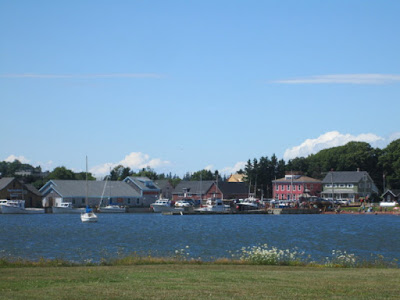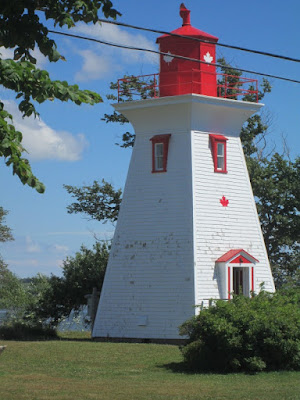For 90 years, beginning in 1827, a perilous method of transportation connected Prince Edward Island to the mainland during the long winter months of ice and snow. Leaving from Cape Jouimain in New Brunswick, large groups of men would alternately drag, paddle or sail small 'iceboats' across the 10 mile passage to P.E.I.
In winter, the Northumberland Strait becomes a dangerous expanse of 'board ice', pressure ridges and open water dotted with fast moving ice floes. To cross, special boats were designed with runners to ease dragging across patches of ice and prows designed to ride up on the ice and allow safe disembarking.
Passengers were allowed to stay in the boats, if they paid the higher fare. Others had to get out and push. The most important cargo back and forth was the mail--the principal impetus for government support of this unique vehicle until it was replaced by ferry service.
Occasionally the ice would not hold. I got so cold looking at these pictures in the Cape Jouimain Visitor Center I went back to the RV and got a jacket.
The ferry service is still in operation between Prince Edward Island and Nova Scotia but 10 years ago the Confederation Bridge was completed and it is now the principal means of transportation between New Brunswick and P.E.I.
The bridge is nine miles long and from the shore it did not look daunting, especially on a sunny day. But I white-knuckled it all the way across. That bridge is too high, too narrow, two-laned, and the sides are not high enough to make me feel safe. If I had brought along a life jacket I would have worn it for the crossing. And the traffic was horrendous with oncoming RVs and trucks pushing me close to the side.
What is even worse...the return trip a week later! It was rainy, windy, and dreary, and the toll to get back was $46! But thankfully, the traffic was almost nonexistent.
But even with that bridge I have to recommend the Island, I truly loved it.
There are three industries here, Tourism (growing--thanks to that bridge), Fishing (disappearing rapidly) and Farming (stable with corn, potatoes, wheat).
The population appears to be shrinking because the younger population is not staying around.
The towns are all small and quaint with neat, well-maintained cottages and farmhouses. I saw several attractive homes for sale for less than $100,000 (Canadian). Unfortunately, unemployment is high.
There were many lighthouses--both real and not real (mailboxes, birdhouses, gift shops, etc)
I also did not see any poverty. Farmhouses would be abandoned like the one here, but a new one would be built nearby.
I had my first, and only lobster dinner for $35.00--the lowest price on the Island. Like the fish, lobster are disappearing from the waters and the price reflects the scarcity.
There are hundreds of these little bays around the island and each one has its own community. The populations are English/Irish, Dutch, and German but some towns are pure Acadia French with a different language, music and food.
The French communities in P.E.I., Nova Scotia and New Brunswick date back to the early 1700s and are the forerunners of the Cajun French of Louisiana. Years after the British expelled them from this part of Canada, many families returned--but they stayed much to themselves.
Water is everywhere, in bays, rivers, small lakes and, of course, the ocean.
Prince Edward Island is the smallest of the Provinces. It is only slightly larger than Delaware at 2195 square miles with only140,000 residents. The largest town is the capital of Charlottetown at 35,000 residents.
I drove through one little fishing town and unexpectedly the road ended at this flat spot.
Well, there were other cars parked here so I thought it would be safe enough to turn around. Then I noticed the kayak sitting in the middle of this parking lot. And some seaweed along the edges of the grass...I was driving on the bay floor! And the tide was out! I did wonder if Spirit would float as I slowly turned and drove back up onto the pavement.
Another Inuksuk
(The first three photos and items in Italics are from the Cape Jouimain Nature Center in New Brunswick)





















No comments:
Post a Comment